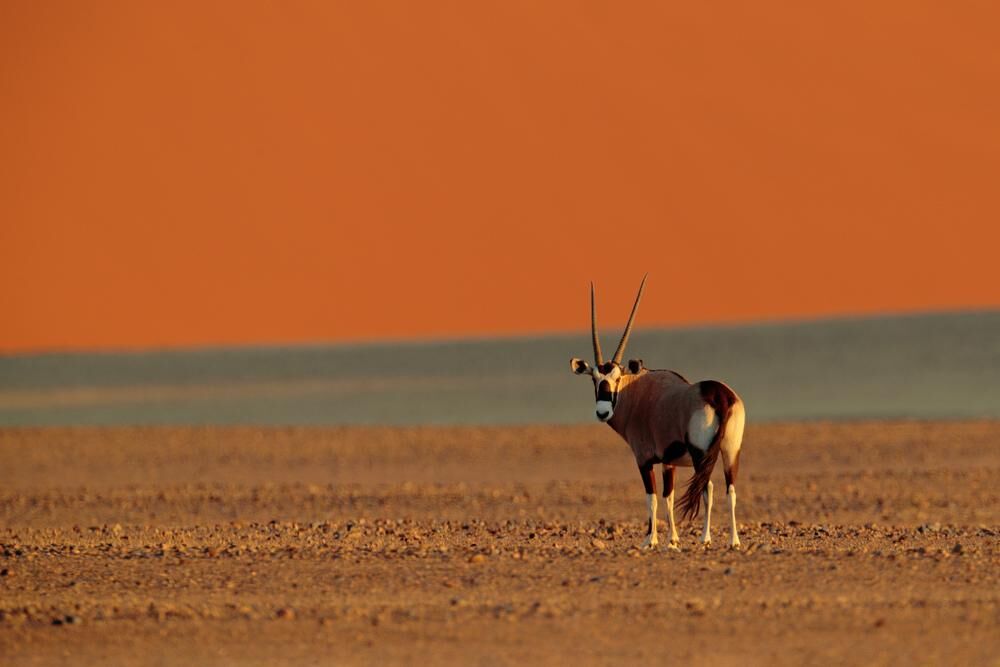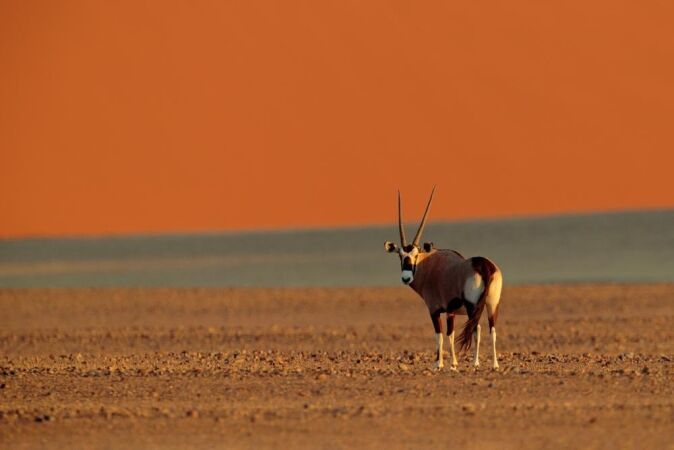

The Gemsbok, or South African oryx (Oryx gazella) is a large antelope endemic to South Africa, Zimbabwe, Botswana, and Namibia. This elegant antelope with its large horns and beautiful coloring remains a firm favorite of many hunters booking an African hunt. Although they are listed with a status of “least concern” by the IUCN, their numbers remain carefully monitored due to poaching and trophy hunting.
One of the more striking African plains game antelopes, the gemsbok prefers rocky plains but can survive in dry and desolate regions, with many inhabiting the Namib and Kalahari Deserts. They are well adapted for survival in these hot areas and can survive without water for prolonged periods. They eat grasses but also dig for roots and tubers that store water. They are diurnal and nocturnal, grazing at night when it’s cooler to gather moisture from water-saturated plants.
The gemsbok defends itself using its long, thick horns, and many predators, including lions, cheetahs, and hyenas, have come horribly short when attacking an adult. Males will also use their horns while sparing with other males and defending their territories.
Breeding season for the gemsbok is year-round, although water and food availability plays a role. The females gestate for 9-10 months, after which one calf is born. She will usually come into heat again within 3-4 weeks of giving birth, leaving little time between pregnancies.
Name:
Oryx Gazella
Male Weight:
500 pounds
Male Shoulder Height:
46-50 inches
Horns:
Both but females are more sought after at 48 inches
Range:
Southern Africa
Life span:
18 years
While Gemsboks are not Currently Endangered, their populations can be affected by Habitat Loss and Overhunting.
The gemsbok is a large antelope renowned for its striking colors. Their coats are a grey-brown color, while their faces and legs are a contrast of black and white markings. They have a long, black tail. Males are heavier than their female counterparts, weighing up to 500 pounds, with females on average 80 pounds lighter. The shoulder height of the gemsbok is approximately 46-50 inches. But, the most impressive feature of a gemsbok is definitely their black horns. This is probably one of the only times a female animal would be sought over a male specimen, as the female’s horn measures an impressive 48 inches compared to a male’s horns that grow to 33-38 inches.
The antelope makes a beautiful trophy and gemsbok hunting in South Africa is extremely popular. Most game hunts will take a walk-and-stalk approach. Be prepared to work hard and cover many miles a day in search of this prized African plains game trophy.
The gemsbok has excellent eyesight, smell, and hearing and your walk-and-stalk approach on this African hunt will therefore need to be exceptionally well-planned and concluded to ensure that this large antelope joins your trophy room. They are alert, always on the lookout for danger, and will snort, grunt, and bleat to warn others in the herd.
Two important factors when hunting gemsbok hunting in South Africa are good optics and premium quality bullets. A gemsbok is an extremely tough antelope to target on an African hunt. A well placed bullet from a .270 shooting 150 grain with a muzzle velocity of at least 2700 feet per second will get the job done. When hunting trophy gemsbok, a larger caliber can also be considered. A wounded gemsbok can go for days ruining a game hunting safari. Any .30 caliber loaded with 165 grain to 180, such as a .308, 30,06 or for longer shots a 300 win mag will work. A .375 with a solid 300 grain bullet is also often a favorite on these extremely tough antelopes.
Search from our range of Hunts across various popular destinations in Africa.
Find A Hunt